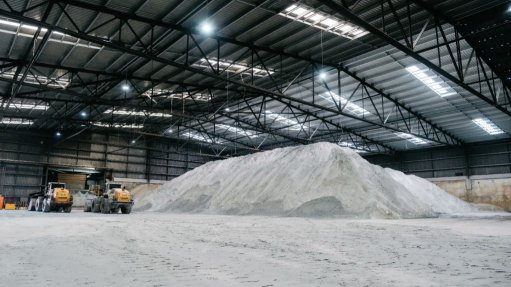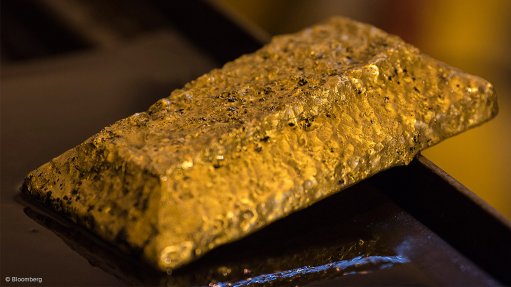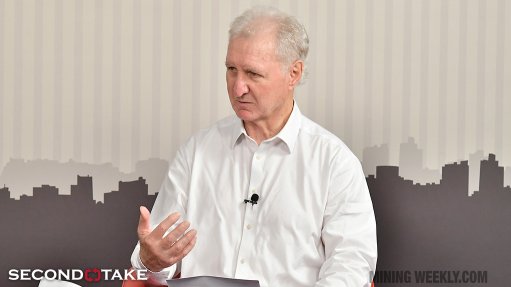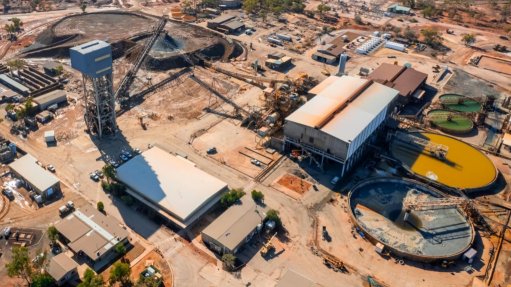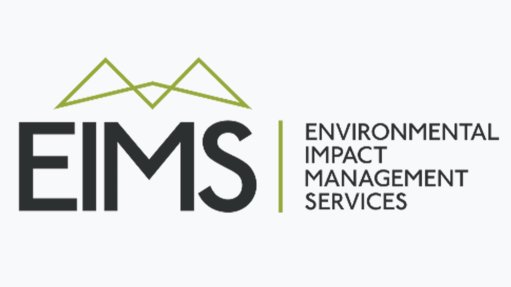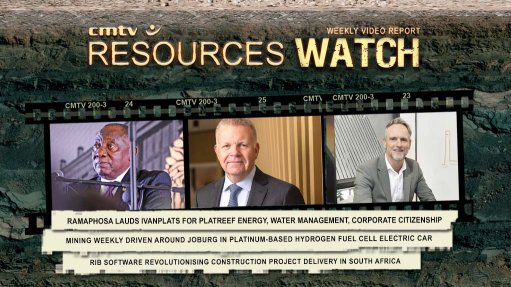Platinum group metals outlook: constrained supply, very strong demand growth – WPIC

World Platinum Investment Council Director of Research Trevor Raymond interviewed by Mining Weekly’s Martin Creamer. Video: Darlene Creamer.
JOHANNESBURG (miningweekly.com) – The outlook for platinum group metals (PGMs) is one of constrained supply and very strong demand growth.
“You’ve got the entire PGMs suite that is short and that certainly will translate into tight markets,” World Platinum Investment Council (WPIC) director of research Trevor Raymond told Mining Weekly in a Zoom interview on Monday. (Also watch attached Creamer Media video.)
“What we’ve already seen is that platinum has traded above $1 100/oz. That’s over 80% above where it was at its lows in March… so, I think the platinum price has got a strong chance of moving strongly towards the gold price and towards the palladium price. Certainly it may be edged on a little bit by incredibly strong rhodium prices as well,” said Raymond.
“The most material driver is the substitution of palladium by platinum. I think we’re starting to see widespread recognition that it’s happening but it’s still proprietary and confidential. We’re starting to see estimates of anything between one and one-and-a-half-million ounces of substitution, people are saying, by 2025. It’s our view that it’s happening a lot quicker and will be a lot sooner. But that’s quite a material growth. You're looking at another one-million ounces within four years in the platinum market. That’s pretty strong demand,” he said.
“Also, the other thing that’s driving demand is investment. People tend to want to not look at investment too seriously. But we’ve had a million ounces of exchange traded fund (ETF) demand in 2019 and another half-a-million ounces in 2020. Certainly, investors are believing that there’s likely to be platinum demand growth from substitution, from higher vehicle loadings and certainly from the recovery in the global economy. The investors have seen that this demand potential is strong. It’s the strongest I’ve seen in the last six years, since we've been doing what we do,” he added.
These are Raymond’s replies to Mining Weekly’s questions:
Is supply likely to keep up with demand?
I suppose the difficulty with supply is that we’ve had years of weak platinum prices. If you look at the strong earnings forecasts that have come out of the PGM mining companies, Sibanye-Stillwater recently and Anglo American Platinum today, I think there’s a large amount of earnings. Share prices are up and profits are good.
But we've seen significantly increased PGM prices since 2018, strong earnings growth. Yet there isn’t one major expansion project that will deliver material demand growth in the short term that is currently under way. There’s a lot of small ones, and certainly those new projects are under discussion right now. But that takes time to discuss, to approve and then to implement.
We’ve seen a strong price performance. Platinum is still under-valued compared with gold and its industrial substitute metal, palladium. There’s still quite some way for platinum to go.
With regard to gold, we’ve seen that there isn’t quite the risk-on appetite the world wanted. The Covid conditions still seem to be lagging a little bit, so there’s still quite a bit of global risk and I think the strong gold price is the outlook, maybe edged on by a bit of inflation fear. So, certainly, a strong gold price is a good for the platinum price.
Then, we’ve seen the improved economic outlook. That’s already reflected in copper, for example, yet for platinum, the position in the futures market are starting to build. Copper, for example, are at three year highs, but platinum’s still probably half the level it was a year ago, so that’s building strongly.
So, I think the platinum price has got a good strong change to move strongly towards the gold price and towards the palladium price. Certainly it may be edged on a little bit by incredibly strong rhodium prices as well.
What are vehicle emission regulations doing to demand?
Tightening emission regulation is something that has been spoken about a lot more but perhaps overlooked to an extent. The big driver, really, is China 6/VI (which forces diesel particulate filters on all new diesel heavy-duty vehicles introduced to the market after July 2021). Emissions legislation in China used to lag those of Europe and of the US. It was always sort of one-and-a-half steps behind. The new China 6/VI regulations are more stringent than Real-Driving Emissions limits in Europe and more stringent than what is in the US. So, we saw in 2019 the massive increase in palladium demand for the mainly gasoline vehicles in China. That certainly continues. So what we’re seeing is that China 6/VI is making incredible demands on palladium and on rhodium and those demands on palladium and on rhodium are certainly resulting in platinum substitution, making huge economic sense, and accelerating a lot quicker. The other thing that emissions legislation is all about is carbon dioxide (CO2). You remember the dieselgate scandal of five years ago was all about nitrogen oxides (NOx). We’ve resolved NOx in Europe and around the world and now the focus is on CO2, and it really is about efficiency. Despite all the bans that are mentioned and the suggestion that we’ll move completely from internal combustion to electric, that is over a long time period. There’s still a huge park of vehicles on the road that need their emissions to be controlled and made tighter. The focus will be on the most CO2 efficient drive trains, and that's where I think there’ll be a lot more of the PGMs required to make sure that any hybrid engines that are internal combustion engines and heavy duty engines are the most CO2-efficient possible and that’s really good for PGMs demand. So, you’ve got the entire PGMs suite that is short and that certainly will translate into tight markets.
Why is substitution of platinum for palladium not made more public?
I think you’ve got the situation where the information about what metals the catalyst manufacturers, Johnson Matthey, BASF and Umicore, put on to catalysts is completely confidential. It’s a very competitive space. It’s very proprietary, so it’s tough for those manufacturers to comment on what the automaker companies are doing. But you know, you’re saving on a mid-sized US pick-up over $170 per vehicle just by substituting 40% of the palladium for platinum, so I have no doubt that it’s happening. You’re starting to hear cautious comments of maybe a million or a million-and-a-half ounces in 2025, that’s four years away. We think that’s happening a lot quicker. So, you're looking at anything between 200 000 oz and 700 000 oz of additional platinum demand required for the substitution, and that’s certainly a big deal in platinum demand. You’re also getting the limited platinum supply growth, which makes the market even tighter. The one thing that you’re probably seeing, and certainly I have over the last seven or eight years, is that a lot of people that were bullish platinum just got worn down and often embarrassed. I think there are a lot of people who are just too afraid to be bullish platinum because they’ve been hurt so many times. And still, people want to ignore investment demand, but to ignore one-and-a-half million ounces that came out of the spot market and that is backing ETFs, the ETF positions tend to be long, and the long view right now is that platinum is under-valued and it’s going to likely play catch-up (to gold and palladium), and the hydrogen economy is not a lot of demand growth but it’s brought more investors in, and when those investors come in, they can see substitution, much higher loadings, likely a much longer internal combustion engine tale, and that’s what’s making investors interested, so, if anything, investment demand is going to become more material and certainly that supply-demand balance is impacted by investment demand, without question.
Will proton exchange membrane (PEM) fuel cells remain inextricably linked to platinum, and what about PEM electrolysers, that require platinum and iridium?
There are two issues. The one is the fuel cell on the vehicle, and the other is producing green hydrogen. Your first question on whether they are inextricably linked. The reason that platinum is used in a fuel cell to propel a vehicle is because of its size. Your home uses maybe 2 kW but you want 100 kW in your vehicle to give you the performance that you’ve become accustomed to. The size of the fuel cell is large and the electrical current density is high and it’s only platinum, really, that can provide that kind of performance in a small enough unit to be on a vehicle. Secondly, what Covid has done is that it has really focused the world on climate change and perhaps with less funding, because of the huge financial cost of the pandemic. So, what you’ve got is that hydrogen actually is, if it’s generated sustainably, a replacement of fossil fuels, and that’s the big focus, and a much higher certainty that the hydrogen economy will evolve. That certainty is, too, to keep carbon emissions neutral, not only in transport, but in heavy industry as well. So, the focus on green hydrogen is the highlight of the fact that if you use a PEM electrolyser, that contains platinum, to produce green hydrogen, from solar power or wind power, that is sustainable. So, the question is, well how much platinum does that mean? It’s interesting, it’s quite good, depending on whether PEM penetration is 30% or 60% and depending on what the loadings are, you’re probably looking at 300 000 oz to 600 000 oz of platinum demand from electrolysers. The question is, yes, and it uses iridium, and iridium is a tight market, the priced has spiked. But it actually really isn’t about PEM electrolysers being that important. The alternative technology, the alkaline electrolyser, is not as efficient, but it’s a perfectly good technology. The real key is getting the price of hydrogen down. If you can get the price of hydrogen down, then you can have more fuel cell vehicles, and it is fuel cell vehicle demand that’s really material for platinum. So, in the next few years, whether PEM takes hold or alkaline takes hold, is not the real issue. The real issue is cheaper hydrogen means more fuel cell vehicles. If you look out ten years, it’s probably in the area eight, nine, ten years when you're going to have fuel cell passenger vehicles. You’ll have a large chunk of battery and a meaningful chunk of fuel cell vehicles that are being led in the short term by heavy-duty, that’s upwards of another million ounces of platinum demand required for fuel cell vehicles. That’s really good news. To see that demand growth occur is really what’s important for platinum and in the short term you can still have your jewellery demand at a higher price giving up metal to provide for that fuel cell growth. The package together, the fact that platinum is so strategic to unlocking the hydrogen economy has led more investors to come and look at platinum. A lot of investors gave up on platinum, those that knew it. When gold reached $2 000/oz a lot of gold investors said it looks like a plateau and they used platinum as a proxy for gold so you’ve got a lot of gold investors coming in, and those make up a lot of investors. We’ve worked really hard over the last six years to take platinum as an investment asset globally to a lot more funds and many of those funds said yes, it’s interesting, and didn't do anything. Those funds are all coming back right now, because of the hydrogen link. And when they come back, they don't see demand growth from hydrogen. They see demand growth from the other things we’re talking about, substitution, higher loadings, more internal combustion, and that’s really what’s driving investment demand and that brings us back to the first point that we discussed, and that is price. This metal is useable, its predictable. If there is growth from South Africa, that growth will be focused on platinum, and certainly that makes the price of platinum looks more interesting than over the last several years.
Article Enquiry
Email Article
Save Article
Feedback
To advertise email advertising@creamermedia.co.za or click here
Announcements
What's On
Subscribe to improve your user experience...
Option 1 (equivalent of R125 a month):
Receive a weekly copy of Creamer Media's Engineering News & Mining Weekly magazine
(print copy for those in South Africa and e-magazine for those outside of South Africa)
Receive daily email newsletters
Access to full search results
Access archive of magazine back copies
Access to Projects in Progress
Access to ONE Research Report of your choice in PDF format
Option 2 (equivalent of R375 a month):
All benefits from Option 1
PLUS
Access to Creamer Media's Research Channel Africa for ALL Research Reports, in PDF format, on various industrial and mining sectors
including Electricity; Water; Energy Transition; Hydrogen; Roads, Rail and Ports; Coal; Gold; Platinum; Battery Metals; etc.
Already a subscriber?
Forgotten your password?
Receive weekly copy of Creamer Media's Engineering News & Mining Weekly magazine (print copy for those in South Africa and e-magazine for those outside of South Africa)
➕
Recieve daily email newsletters
➕
Access to full search results
➕
Access archive of magazine back copies
➕
Access to Projects in Progress
➕
Access to ONE Research Report of your choice in PDF format
RESEARCH CHANNEL AFRICA
R4500 (equivalent of R375 a month)
SUBSCRIBEAll benefits from Option 1
➕
Access to Creamer Media's Research Channel Africa for ALL Research Reports on various industrial and mining sectors, in PDF format, including on:
Electricity
➕
Water
➕
Energy Transition
➕
Hydrogen
➕
Roads, Rail and Ports
➕
Coal
➕
Gold
➕
Platinum
➕
Battery Metals
➕
etc.
Receive all benefits from Option 1 or Option 2 delivered to numerous people at your company
➕
Multiple User names and Passwords for simultaneous log-ins
➕
Intranet integration access to all in your organisation







